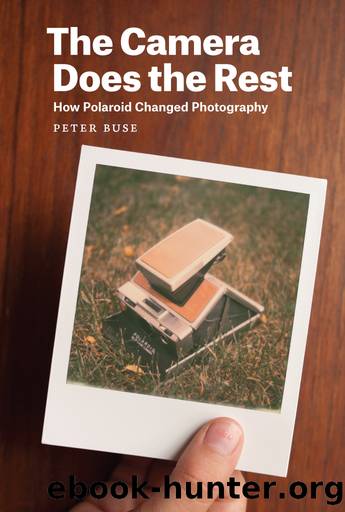The Camera Does the Rest: How Polaroid Changed Photography by Peter Buse

Author:Peter Buse [Buse, Peter]
Language: eng
Format: epub
ISBN: 9780226312163
Publisher: University of Chicago Press
Published: 2016-02-14T16:00:00+00:00
In other words, the symbolic value of an expensive representative of the fine camera field matters as much to its owner as any purely photographic functions it may be capable of performing. A wealthy person cannot risk being seen with a cheap camera, but equally, must not dedicate too much energy to using the fancy camera, which is mainly for show. If we return briefly to the Hugh Laurie ad, Bourdieu helps us to understand what is being mocked there. The would-be expert flummoxed by a camera that does it all for him is in fact part of a tradition of satirical censure of the “vulgarity” of the “passion for photography,” a censure “which reprimands the naïve enthusiasm of photographic fanatics and gibes at their ridiculous paraphernalia.”58
The SX-70 came with plenty of paraphernalia for anyone with deep pockets, and Polaroid’s glossy literature on the camera also made claims for its profound cultural significance. Land’s introduction to “The SX-70 Experience” asks, “Is it magic that our magic device in its technological innocence appears on the scene suddenly as an invaluable instrument for discernment of prehistoric bonds to each other? Or does the race simply await the random arrival of technologies that prove benign, interspersed amongst those that prove to be evil?”59 In retrospect this sounds rather grandiose, but there is no reason to believe Land was not genuine in his hopes for the camera. It was with such ambitions in mind that Charles and Ray Eames were enlisted to make their short film about it, complete with score by Elmer Bernstein and a concluding commentary by the eminent physicist Philip Morrison. That the leading designers of the era agreed to make the film shows the extent to which SX-70 was considered a cultural as well as a technical achievement, even if, as I showed in chapter 1, the film brings to the fore its toy-like qualities (Charles Eames went on to make a promotional short about the Polavision movie camera, and the couple made a number of “Vignettes” using Polavision).60
Perhaps the greatest coup by Polaroid in the marketing of SX-70 was the recruitment of Laurence Olivier to work in his first and only television ad campaign. Olivier was performing in Paris at the time, and so took to the stage at the Théâtre Nationale to film the four spots. Announcing the “age of miracles” and describing the camera as “quite simply doing the impossible,” he proceeded to photograph bunches of flowers in one ad, an antique clock in another. The flowers were to illustrate the color palette of the film, the antique clock to suggest fine craftsmanship and cultural value, but more important was the absence on the Parisian stage of those old standbys of snapshot photography: children, pets, birthday parties. Polaroid might have sought out a more recognizable American face to front the SX-70 campaign, but the choice of Olivier, whom they considered the world’s finest actor, made clear the intended associations of the SX-70 with high culture.61 As with
Download
This site does not store any files on its server. We only index and link to content provided by other sites. Please contact the content providers to delete copyright contents if any and email us, we'll remove relevant links or contents immediately.
The Secret History by Donna Tartt(18053)
Red Sparrow by Jason Matthews(5165)
Harry Potter 02 & The Chamber Of Secrets (Illustrated) by J.K. Rowling(3531)
In a Sunburned Country by Bill Bryson(3331)
Drawing Cutting Edge Anatomy by Christopher Hart(3256)
Figure Drawing for Artists by Steve Huston(3242)
Harry Potter and the Prisoner of Azkaban (Book 3) by J. K. Rowling(3082)
The Daily Stoic by Holiday Ryan & Hanselman Stephen(3075)
Japanese Design by Patricia J. Graham(2976)
The Roots of Romanticism (Second Edition) by Berlin Isaiah Hardy Henry Gray John(2801)
Make Comics Like the Pros by Greg Pak(2731)
Stacked Decks by The Rotenberg Collection(2662)
Harry Potter and the Deathly Hallows (7) by J.K. Rowling(2519)
Draw-A-Saurus by James Silvani(2475)
Tattoo Art by Doralba Picerno(2466)
On Photography by Susan Sontag(2459)
Foreign Devils on the Silk Road: The Search for the Lost Treasures of Central Asia by Peter Hopkirk(2372)
Churchill by Paul Johnson(2330)
Drawing and Painting Birds by Tim Wootton(2311)
